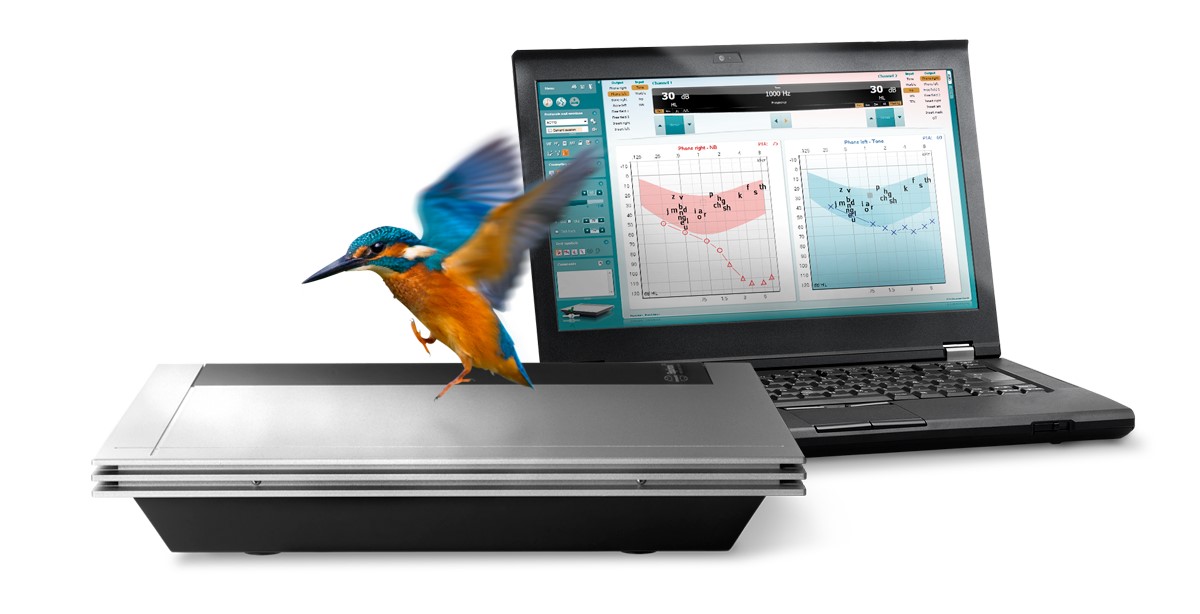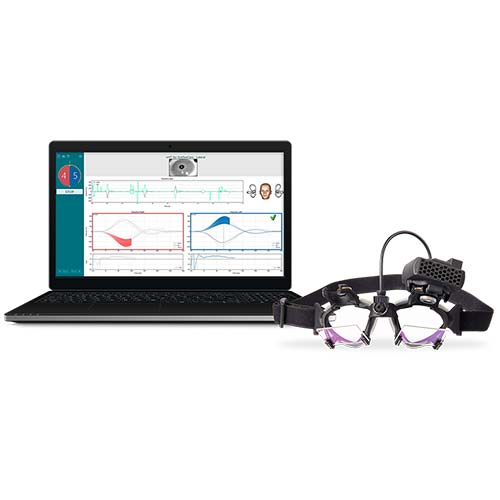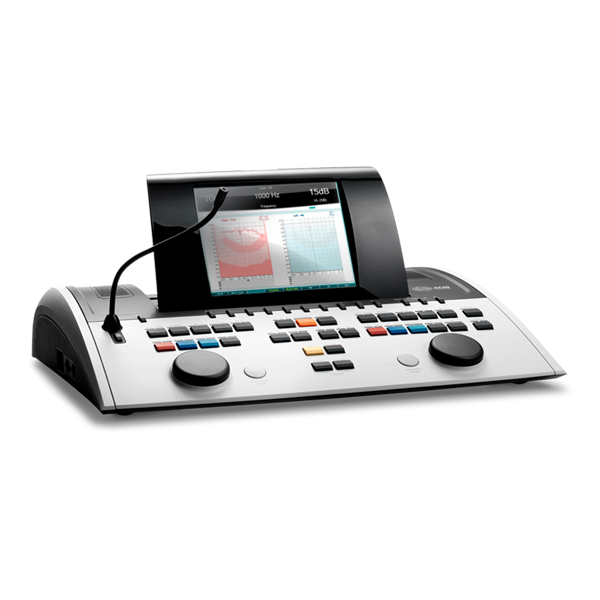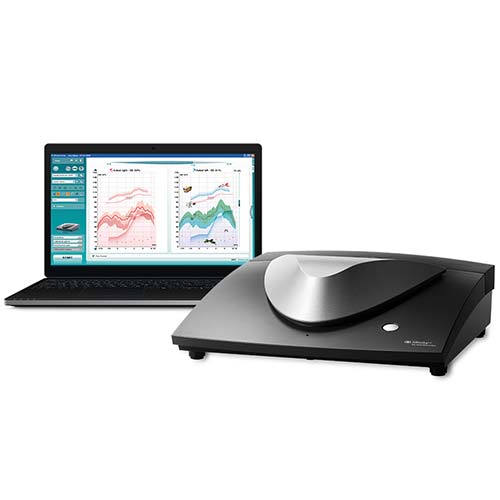Description
| SPECIFICATION | |
|---|---|
| Model | Eclipse |
| Manufacturer | Interacoustics |
| Country of Origin | Denmark |
| Included Parts |
Two channel evoked potential system that allows for recording ABRs, middle and late latency potential
Assists in the assessment of vestibular function.
Audiologic evaluation and documentation of ear disorders using transient evoked otoacoustics emissions
Audiologic evaluation and documentation of ear disorders using distortion product otoacoustics emissions
Analysis of human physiological data for the diagnosis of auditory and hearing related function
Audiologic evaluation and documentation of ear and nerve disorders using auditory evoked potentials from the inner ear, the auditory nerve and the brainstem. Target population is newborns
|
| Optional Part |
|
| Test types / Functionality |
|
| TECHNICAL SPECIFICATION | ||
|---|---|---|
| Power Supply | Input Volt: 100-240VAC / 50/60Hz Consumption: 26W (0.3A max) | |
| Weight | 2.5kg / 5.5lb including accessories | |
| Dimensions (L×W×H) | 28×32×5.5 cm / 11×12.6×2.2 inch | |
| Construction | Metal cabinet | |
| Compatible Software | Diagnostic Suit – Noah OtoAccess | |
| Display | XML Compatible | |
| Warm Up Time | 10 minutes at room temperature | |
| PC Control | USB 1.1 or 2.0 for input/output for computer communication Eclipse is fully operated from a PC | |
| Operation Environment | Temperature: 15 – 35 °∁ Relative Humidity: 30 – 90 % Ambient Pressure: 98 – 104 kPa |
|
| EP 25 / VEMP Specifications | ||
| EPA Preamplifier | Two channels standard | EPA4 Cable Collector (4 electrodes). Standard 50 cm. Option: 5cm or 290 cm |
| One Channel (optional) | EPA3 Cable Collector (3 electrodes). 50 cm | |
| Gain: | 80 dB/60 dB | |
| Frequency response: | 0,5 – 5000 Hz | |
| CMR Ratio: | Minimum >118 dB. Typical 130 dB < 100 Hz | |
| Radio frequency | Typically 25 dB improvement over previous available | |
| Max input offset | desig | |
| Input impedance | 10 MΩ/ 170 pF | |
| Power from main unit | Insulated power supply with 1500 V isolation. The signal is digitally/capacitive insulated | |
| Stimulus: | Stimulus rate: | 0.1 to 80.1 stimuli per second in steps of 0.1. |
| Envelopes/Windows : | Bartlett, Blackman, Gaussian, Hamming, Hanning, Rectangle and Manual (Rise/Fall and Plateau) | |
| Masking: | White noise. Calibrated and presented in SPL. | |
| Transducer: | Ear Tone ABR insert phone, calibrated on an IEC 711 coupler.Headphone with independent calibration (optional) Bone conductor (optional) | |
| Level | 20 – 135.5 dB peSPL, (-10 – 100 dB nHL) in 1 dB steps | |
| Polarity: | Condensation, Rarefaction, Alternating | |
| Click: | 100 μs (200Hz -11kHz) | |
| Tone Burst Frequency | 250, 500, 750, 1000, 1500, 2000, 3000, and 4000 Hz. | |
| Tone Burst Stimulation Time: | Stimulation up to 780 ms | |
| NB CE-Chirp® LS Freq.: | 500, 1000, 2000 and 4000 Hz | |
| Broadband CE-Chirp®: | 200Hz -11kHz | |
| LS 200Hz -11kHz Relative Masking Level: | +30dB to -40 dB relative to stimulus level. The stimulus level ispresented in nHL. The masking level is only presented in SPL, and can therefore not exceed the loudness of the stimulus. | |
| Recording: | Analysis Time: | -150 ms prior to stimuli and up to 1050 ms dependent). |
| A/D Resolution | 16 bit. | |
| Sampling frequency | 30 kHz | |
| Artifact Reject System: | Standard voltage based system | |
| Rejection levels: | Manual 0.2 – 640 μV input with 0.1uV steps. | |
| Anti-aliasing filter | Analog 5kHz, 24 dB / octave | |
| Dots per Trace: | 450 displayed. | |
| Low Pass Filter: | None or 17 – 12000 Hz depend on the measurement type | |
| High Pass Filter: | 0.83 Hz to 500 Hz depending on the measurement type. | |
| DSP Low Pass Filter: | 100, 300, 750, 1k, 1,5k, 2k, 3k, 4k, 5k, 7,5k Hz | |
| DSP High Pass FilterDSP High Pass Filter | 0.5, 1.0, 3.3, 10, 33, 100 Hz | |
| Display Gain: | General Display Gain. Applicable during testing. Single Curve Display Gain. Applicable during testing. | |
| Controlled parameters: | Stimuli Rate, Number of stimuli, Polarity, Click, Tone Burst, Stimulus intensity, Number of curves per intensity, Intensity, Soft attenuator, Stimulus ear, Transducer, Masking level, Preliminary filter setting, Recording onset, Automatic next intensity, General Display Gain, Single Curve Display Gain, Baseline, Latency norm, Report templates, Print out, Manual stimulus to familiarization, Talk Forward. | |
| Data collection: | Impedance test, Waveform buffer, Curve, Online EEG, Waveforms storage in unlimited storage database | |
| Data Recovery: | Lost data due to crash of Windows® will in almost all cases be Available upon re-establishing Windows operation. | |
| TEOAE 25 Specification | ||
| Stimulus: | Type: | Click (Linear or Non-linear) |
| Bandwidth: | 500 – 5500 Hz | |
| Level: | 50-90 dB SPL | |
| Level Step: | 1 dB SPL | |
| Transducer: | Dedicated TEOAE25 probe (Accuracy 0.5 dB) | |
| Recording: | Recording: Analysis time: | 25 to 32000 samples |
| Sampling frequency | 30 kHz | |
| A/D Resolution | 16 bit, 3.7 Hz resolution | |
| Artifact Reject System: | 25 – 55 dB SPL or off. Applicable during testing | |
| SNR Criteria | 5 individual frequency bands can be set 1-30 dB SPL | |
| Display gain: | General Display gain | Applicable during testing |
| DPOAE 20 Specification | ||
| Stimulus: | Frequency Range: | 500-8000 Hz |
| Frequency Step: | 50 Hz | |
| Level: | 30-75 dB SPL (70 dB above 6kHz) | |
| Level Step | 1 dB SPL | |
| Transducer: | Dedicated DPOAE20/TEOAE25 probe | |
| Recording: | Analysis time: | minimum 2 sec to unlimited test time |
| A/D Resolution | 16 bit, 3.7 Hz resolution | |
| Sampling frequency | Sampling frequency | |
| Artifact Reject | -30 – 30 dB SPL or off. Applicable during testing | |
| Stimulus Tolerance | Adjustable | |
| SNR Criteria | Adjustable | |
| Probe check window | 256 points frequency response of the ear canal due to a click | |
| DP-Response window | 4096 point frequency response | |
| Display gain: | General Display gain | Applicable during testing |
| EPA Preamplifier | Two channels standard | EPA4 Cable Collector (4 electrodes). |
| One Channel (optional): | EPA3 Cable Collector (3 electrodes). 50 cm | |
| Gain: | 80 dB/60 dB | |
| Frequency response: | 0,5 – 5000 Hz | |
| CMR Ratio: | Minimum >118 dB. Typical 130 dB < 100 Hz | |
| Radio frequency immunity: | Typically 25 dB improvement over previous available designs | |
| Max input offset voltage | 2,5 V | |
| Input impedance: | 10 MΩ/ 170 pF | |
| Power from main unit: | Insulated power supply with 1500 V isolation. The signal is | |
| Specifications as EPA4 Impedance measurement: | Selectable for each electrode | |
| Measurement frequency | 33 Hz | |
| Waveform | Rectangular | |
| Measurement current | 19μA | |
| Range: | 0.5 kΩ – 25 kΩ | |
| Stimulus: | Stimulus rate: | 93 Hz |
| Level: | 30, 35, 40 dBnHL | |
| Click: | 100 μs | |
| Recording: | Analysis time: | 120 seconds |
| A/D resolution: | 16 bit | |
| Sampling frequency | 30 kHz | |
| Artifact rejection system | Standard voltage based system | |
| Display: | Stimulus level and type, Graph view | |
| Security: | Password protection of test parameters possible. | |
| Algorithmic | Click: | 99.99% |
| Sensitivity | Click: | ≥ 97% |
| ABRIS Module Specification | |
| Stimulus type | Click |
| Stimulus rate | 93 Hz |
| Stimulus intensity | 30, 35, 40dB nHL |
| Test time | 120 seconds (default) |
| Test montage | mastoid or nape |
| Test method | monaural |
| User customizable protocols | X |
| Password protection of test parameters | X |
| ASSR Module Specification | |
| Stimulus level | 0 – 100 dB nHL |
| Narrow Band CE-Chirp® stimuli (0.5, 1, 2, 4 kHz) | X |
| Recording time | Up to 15 min per curve |
| Stimulus rate | 40 or 90 Hz |
| Transducer options | Headphone, DT48A, Inserts, Bone |
| nHL to eHL correction factors (Child/Adult) | X |
| Residual noise calculator | X |
| User customizable protocols | X |
| Noah 4 and higher compatibility | X |






Reviews
There are no reviews yet.